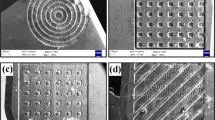Abstract
PCBN offers high potentials in turning or milling of ferrous materials and highly heat resistant materials. Due to its thermal stability PCBN achieves a longer tool life than PCD despite its lower hardness. These properties currently lead to high production costs of the PCBN inserts. Generally, plunge face grinding with diamond grinding cup wheels is the final machining step in the process chain of the PCBN-insert production. The grinding process of PCBN inserts is characterized by a high amount of grinding wheel wear from the first contact. Normally the ratio between the worn grinding layer and the material removal is lower than one. To increase the productivity the relationships between grinding wheel properties, process parameters and PCBN insert specifications have to be obtained. In an initial step the main factors on the grinding wheel wear and cutting mechanisms are determined. The statistically evaluated results show, that the productivity of the grinding process can be adjusted independently of the achieved PCBN inserts. The process parameters affects only the productivity in the considered area. High insert qualities like sharp cutting edges and low roughness values on the flank face can be produced by the use of small abrasive grains.












Similar content being viewed by others
References
Wentorf RH (1957) Cubic form of boron nitride. J Chem Phys 26:956
McKie A et al (2011) Mechanical properties of cBN–Al composite materials. Ceram Int 37(1):1–8
Clark TJ, DeVries R (1993) C: super abrasives and ultrahard tool materials. ASM International, Almere, pp 1008–1018
Sumiya H, Uesaka S, Satoh S (2000) Mechanical properties of high purity polycrystalline cBN synthesized by direct conversation sintering method. J Mater Sci 35:1181–1186
Hooper RM (1991) Indentation studies of cBN–TiC composites. J Hard Mater 3–4(2):223–231
Salmag H, Scholze H (2007) Keramik. Springer, Berlin
Uesaka S, Sumiya H (1999) Mechanical properties and cutting performances of high purity polycrystalline CBN compact. Manufacturing science and engineering, Nov 14–Nov 19, Nashville, TN, USA. American Society of Mechanical Engineers, Manufacturing Engineering Division, vol. 10, pp 759–766
Cook MW, Bossom PK (2000) Trends and recent development in the material manufacture and cutting tool application of polycrystalline diamond and polycrystalline cubin boron nitride. Int J Refract Metal Hard Mater 18:147–152
Kress J (2007) Auswahl und Einsatz von polykristallinem kubischem Bornitrid beim Drehen, Fräsen und Reiben. Dr.-Ing. thesis, Technical University Dortmund
Biermann D, Baschin A, Krebs E, Schlenker J (2011) Manufacturing of dies from hardened tool steels by 3-axis micromilling. Prod Eng Res Devel 5(2):209–217
Sieben B, Wagner T, Biermann D (2010) Empirical modeling of hard turning of AISI 6150 steel using design and analysis of computer experiments. Prod Eng Res Devel 4:115–125
Michels C (2003) Nur mit optimalem system: Schleifen von CBN-/PKD-Werkzeugen. VDI-Z Special Werkzeuge, pp 59–61
Denkena B, Köhler J, Ventura CEH (2014) Grinding of PCBN cutting inserts. Int J Refract Met Hard Mater 42:91–96
Mamalis AG, Horvath M, Grabchenko AI (2000) Diamond grinding of super-hard materials. J Process Technol 97:120–125
Butler-Smith P (2003) The economics of rapid grinding of PCD and PCBN cutting tools. Ind Diam Rev 1(03):20–23
Friemuth T (1999) Schleifen hartstoffverstärkter keramischer Werkzeuge. Dr.-Ing. thesis. University Hanover
Kleppmann W Versuchsplanung—Produkte und Prozess optimieren. Hanser Verlag. ISBN: 987-3-446-42774-7
Klocke F, König W (2008) Fertigungsverfahren: Drehen, Fräsen, Bohren, 8th edn. Springer, Berlin
Guter T (2009) Kantenpräparation an Wendeschneidplatten. In: Tikal F (ed) Schneidkantenpräparation: Ziele, Verfahren und Messmethoden. Kassel University Press, Kassel, pp 71–86
Gossett WS (1908) The probable error of a mean. In: Biometrika. 6, Nr. 1, March, pp 1–25
Werner G (1971) Kinematik und Mechanik des Schleifprozesses, Dr.-Ing. thesis, TH Aachen
Wobker H-G (1992) Schleifen keramischer Schneidstoffe. Dr.-Ing. thesis. Universität Hannover
Denkena B, Köhler J, Ventura CEH (2014) Influence of grinding parameters on the quality of high content PCBN cutting inserts. J Mater Process Technol 214:276–284
Acknowledgments
The research Project DE447/98-1 “Wear mechanism during grinding of PCBN inserts” is funded by the German Research Foundation (DFG).
Author information
Authors and Affiliations
Corresponding author
Rights and permissions
About this article
Cite this article
Denkena, B., Grove, T. & Behrens, L. Significant influence factors on the grinding tool wear and cutting mechanisms during grinding of PCBN inserts. Prod. Eng. Res. Devel. 9, 187–193 (2015). https://doi.org/10.1007/s11740-015-0599-6
Received:
Accepted:
Published:
Issue Date:
DOI: https://doi.org/10.1007/s11740-015-0599-6




